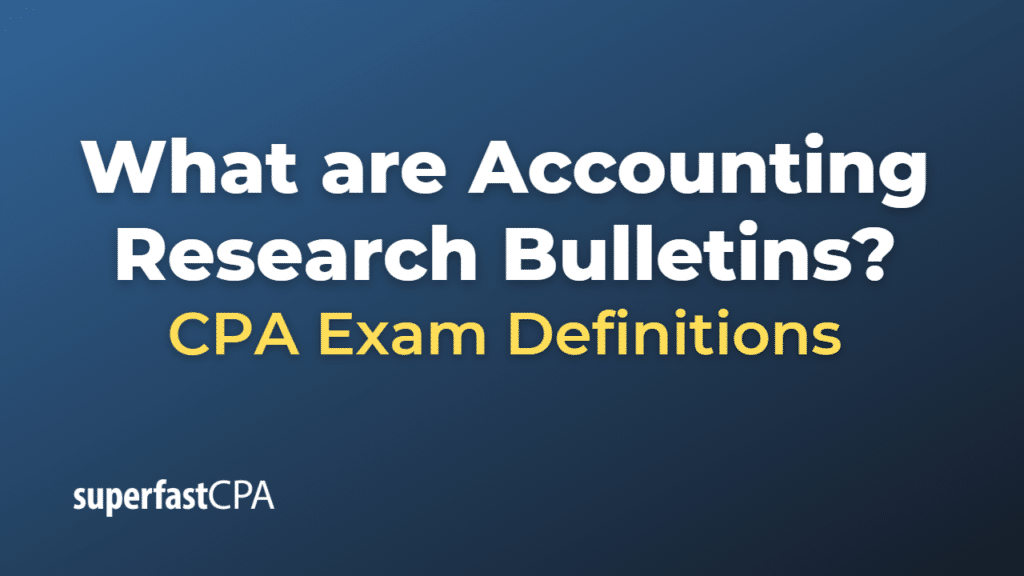Accounting Research Bulletins
Accounting Research Bulletins (ARBs) were a series of publications issued by the Committee on Accounting Procedure (CAP) of the American Institute of Certified Public Accountants (AICPA) between 1939 and 1959. The purpose of these bulletins was to provide guidance, interpretations, and recommendations on various accounting principles and practices.
The Committee on Accounting Procedure was an early standard-setting body in the United States and aimed to improve accounting practices and increase consistency and comparability among financial statements. The ARBs were influential in shaping the development of accounting principles in the U.S. during that time.
In total, 51 ARBs were issued, covering topics such as revenue recognition, depreciation, inventory valuation, consolidations, and contingencies, among others. However, the ARBs were criticized for being based on individual cases and lacking a coherent framework or a set of underlying principles.
In 1959, the AICPA replaced the Committee on Accounting Procedure with the Accounting Principles Board (APB), which took over the role of setting accounting standards in the United States. The APB issued Accounting Principles Board Opinions (APBOs) as its primary form of guidance.
Later, in 1973, the Financial Accounting Standards Board (FASB) was established as the new independent standard-setting body in the U.S., replacing the APB. The FASB developed the Generally Accepted Accounting Principles (GAAP), which is the current framework for accounting standards in the United States. Over time, many of the ARBs were superseded or incorporated into the GAAP framework as accounting standards evolved.
Example of Accounting Research Bulletins
One example of an Accounting Research Bulletin (ARB) is ARB No. 43, “Restatement and Revision of Accounting Research Bulletins,” which was issued in June 1953. ARB No. 43 is particularly noteworthy because it served as a comprehensive restatement and revision of the previously issued ARBs, consolidating and updating the guidance contained in those bulletins.
ARB No. 43 contained several chapters, each addressing different accounting topics. Here’s an example from Chapter 4: “Inventory Pricing,” which provided guidance on inventory valuation methods:
Section A of Chapter 4 discussed the basic principles of inventory valuation. It emphasized that the primary basis of accounting for inventory is cost, which is defined as the sum of the applicable expenditures and charges directly or indirectly incurred in bringing an article to its existing condition and location.
The bulletin also provided examples of acceptable inventory valuation methods, including:
- Specific identification method: This method assigns the actual cost of each item in inventory to that specific item. It is particularly appropriate for businesses dealing with unique or high-value items, such as automobiles or jewelry.
- First-in, first-out (FIFO) method: This method assumes that the first items purchased or produced are the first ones to be sold. Consequently, the ending inventory consists of the most recently acquired items. This method is commonly used in industries where inventory items are relatively homogeneous and have a high turnover rate.
- Last-in, first-out (LIFO) method: This method assumes that the last items purchased or produced are the first ones to be sold. As a result, the ending inventory consists of the oldest items. The LIFO method is often used in industries that experience significant price fluctuations or inflation.
- Weighted-average cost method: This method calculates the average cost of all items in inventory and assigns this cost to each item. The weighted-average cost method is suitable for businesses with large quantities of similar items in inventory.
ARB No. 43, along with other ARBs, played an essential role in shaping accounting practices in the United States during its time. However, as mentioned earlier, many of the ARBs have been superseded or incorporated into the current Generally Accepted Accounting Principles (GAAP) framework as accounting standards have evolved.













